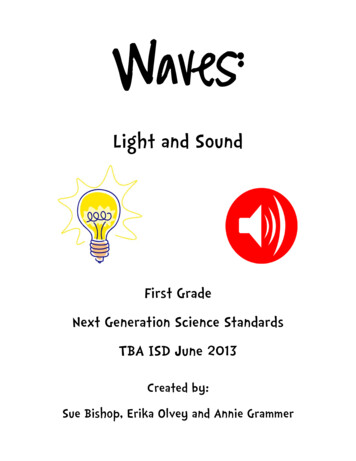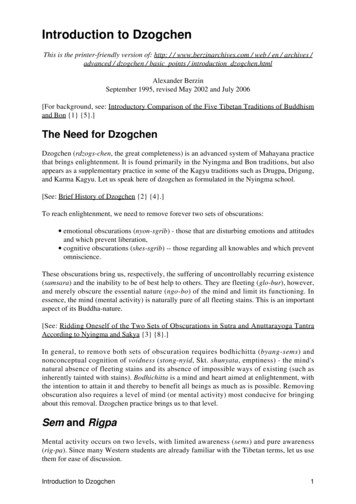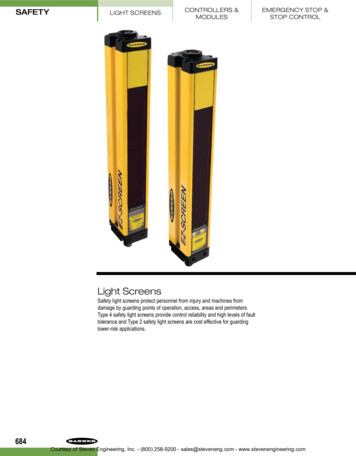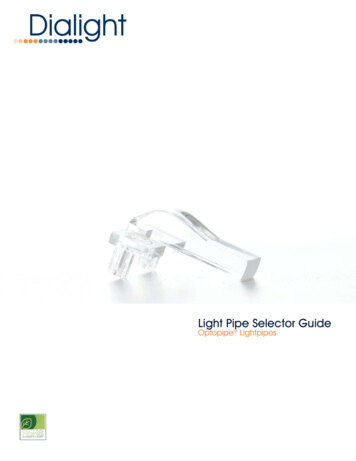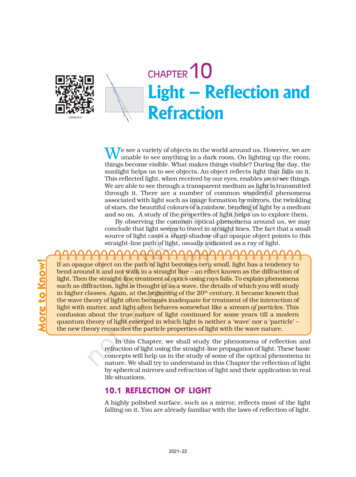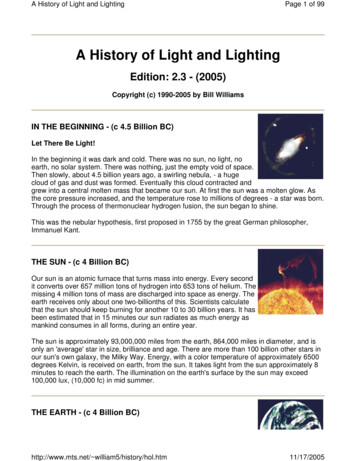
Transcription
A History of Light and LightingPage 1 of 99A History of Light and LightingEdition: 2.3 - (2005)Copyright (c) 1990-2005 by Bill WilliamsIN THE BEGINNING - (c 4.5 Billion BC)Let There Be Light!In the beginning it was dark and cold. There was no sun, no light, noearth, no solar system. There was nothing, just the empty void of space.Then slowly, about 4.5 billion years ago, a swirling nebula, - a hugecloud of gas and dust was formed. Eventually this cloud contracted andgrew into a central molten mass that became our sun. At first the sun was a molten glow. Asthe core pressure increased, and the temperature rose to millions of degrees - a star was born.Through the process of thermonuclear hydrogen fusion, the sun began to shine.This was the nebular hypothesis, first proposed in 1755 by the great German philosopher,Immanuel Kant.THE SUN - (c 4 Billion BC)Our sun is an atomic furnace that turns mass into energy. Every secondit converts over 657 million tons of hydrogen into 653 tons of helium. Themissing 4 million tons of mass are discharged into space as energy. Theearth receives only about one two-billionths of this. Scientists calculatethat the sun should keep burning for another 10 to 30 billion years. It hasbeen estimated that in 15 minutes our sun radiates as much energy asmankind consumes in all forms, during an entire year.The sun is approximately 93,000,000 miles from the earth, 864,000 miles in diameter, and isonly an 'average' star in size, brilliance and age. There are more than 100 billion other stars inour sun's own galaxy, the Milky Way. Energy, with a color temperature of approximately 6500degrees Kelvin, is received on earth, from the sun. It takes light from the sun approximately 8minutes to reach the earth. The illumination on the earth's surface by the sun may exceed100,000 lux, (10,000 fc) in mid summer.THE EARTH - (c 4 Billion BC)http://www.mts.net/ william5/history/hol.htm11/17/2005
A History of Light and LightingPage 2 of 99About 4 billion years ago, soon after the Sun was formed, the Earth andour other planets were formed from violent explosions and spinoffs from the process thatcreated the Sun. The nine planets created are now known as Mercury, Venus, Earth, Mars,Jupiter, Saturn, Uranus, Neptune and Pluto, (arranged in order, from the sun). As rocks andother particles collided forming the Earth, it became molten. The rocks liquefied and theheavier elements sank to the core of the planet. The surface of the Earth cooled andhardened. Gradually oceans appeared and sunlight and water gave birth to life, eventually,intelligent life.The earth has a diameter of 7,900 miles (compared to the sun's diameter of 864,000 miles).EARLY LIFE - (c 3 Billion BC)Without light, there would be no life. Life was dependent on three thingsbeing present: a.) the basic long molecule building block, carbon, b.)water, and c.) light. The Earth had all three. Eventually the oceansformed a rich organic soup that ultimately bore life. The oldest verifiedevidence of life comes from Rhodesia, where rocks formedapproximately 3 billion years ago, bear 'stromatolites', the fossilizedremains of algae.Originally our atmosphere contained; hydrogen, helium, nitrogen, methane, ammonia andwater vapor. For millions of years, the waste product of oxygen, from the ocean's algae,bubbled up out of the sea and into the atmosphere. Gaseous oxygen reacted strongly with themethane and ammonia in the atmosphere, turning it into carbon dioxide and water vapor. Overtime, methane, ammonia and carbon dioxide were almost eliminated from the atmosphere. Asoxygen began to build up in the atmosphere, the usual oxygen module (0-2) began to absorbultraviolet wavelengths from the sun to form three atom molecules (0-3). In time a layer ofpoisonous ozone had built up high in the atmosphere, about 30 miles above the surface of theEarth. This ozone layer effectively blocked much of the damaging ultraviolet rays fromreaching the Earth. Paleontological records show that life moved from the sea to land, onlyafter the ozone layer had formed, providing a 'sunscreen' to protect the land from harmfulultraviolet radiation.Today, the air we breath today is approximately 78 percent nitrogen, 20 percent oxygen and 2percent noble gases, carbon dioxide and water vapor.PHOTOSYNTHESIS - (c 2 Billion BC)Somehow, as the primitive ocean organisms developed, one managed to develop a moleculethat could use the energy of sunlight to produce food for itself. Sunlight, water, carbon dioxideand simple inorganic elements were all that was needed to sustain itself. No longer did oceancreatures have to eat other ocean creatures to survive. This was the birth of the first'autotroph', a creature that could manufacture its own food. The plant was born and theprocess of photosynthesis had begun.http://www.mts.net/ william5/history/hol.htm11/17/2005
A History of Light and LightingPage 3 of 99FIRST MAN - HOMO ERECTUS EMERGES - (c 1 Million BC)EARLY MAN - (c 500,000 BC)For people that lived before the dawn of history, there was no such thing as a solar system.The world as they understood it, was a small patch of land bounded perhaps by hills and bythe blue line of the sea. Overhead was the sky, and across it rode the sun, a god, giving lightand warmth. The moon was a lesser god, shining with a lesser light, and with it at night, rodethe brilliant innumerable stars. Outside of this little universe, lay unimagined mystery.FIRE, FLAME and TORCH - (c 400,000 BC)Homo erectus probably discovered fire by accident. Fire was most likely given to man as a 'giftfrom the heavens' when a bolt of lightning struck a tree or a bush, suddenly starting it on fire.The flaming touch and the campfire probably constituted early man's first use of 'artificial'lighting. For the first time man gained some small degree of freedom from the blindness ofnight, and some small degree of safety from the fear of unseen prowling beasts. As early as400,000 BC, fire was kindled in the caves of Peking man.The torch was the first portable lamp. One of the earliest developments was the discovery thata bundle of sticks tied together made a blazing torch, producing a brighter and longer lastinglight. Man had finally learned to control fire and the human race was on the road to civilization.The discovery of fire has had such a profound effect on humankind that all early societiesconstructed a myth to commemorate it. Years later, to the ancient Greeks, the fire bringer wasPrometheus.ANCIENT ART - (c 28,000 BC)In the Ice Age snow and cold of 30,000 years ago, Cro-Magnon artists used natural pigmentsto create primitive paintings. Excellent examples of early art have been found in the cave atLascaux, in France. Clearly man must have been using fire to provide the necessary light tocreate his art, as many painting have been found deep within caves, far beyond the reach ofdaylight.PRIMITIVE LAMPS - (c 13,000 BC)Prehistoric man, used primitive lamps to illuminate his cave. These lamps, made from naturallyhttp://www.mts.net/ william5/history/hol.htm11/17/2005
A History of Light and LightingPage 4 of 99occurring materials, such as rocks, shells, horns and stones, were filled with grease and had afiber wick. Lamps typically used animal or vegetable fats as fuel. Hundreds of these lamps(hollow worked stones) have been found in the famous Lascaux caves (France), dating toabout 15,000 years ago.The Sumerians of 2600 BC left behind them alabaster lamps so close to shell form that it isindisputable that shells themselves must have been used long before. Early man also realizedthat a crude reflector would help direct and intensify the light. Niches have been found carvedinto cave walls that are thought to have served this purpose.In the Mediterranean area, hand fabricated lamps appear in Palestine, before 2000 BC.Additional Reading: Greek and Roman Pottery Lamps, Donald Bailey, British Museum, 1972.WORLD POPULATION - (8000 BC) - 100,000 people.AGRICULTURE - (c 8000 BC)About ten thousand years ago, man made an incredible discovery. For hundreds of thousandsof years before, man has been a hunter/gatherer. Once man realized that he could actuallyplant crops and harvest them at specific times he now had a stable food supply. Man haddiscovered agriculture and now was able to settle down and farm a small patch of land. Theknowledgeable use of light and other important factors brought man new freedom.Successful agriculture meant for the most part predicting the seasons. Whoever could predictthe coming of spring, the flooding of fertile river planes and the proper time to harvest - wascertainly a god or a magician. It is possible that many ancient monuments were built to predictthe coming of the seasons. The [STONEHENGE] is an example.ANIMAL LAMPS - (c 5000 BC)Animals were also used as lamps. Oily birds and fish needed only be threaded with a wick toproduce a working lamp.There are also records of the early use of fireflies to provide man with a source of convenientlight. In the West Indian Islands (and also in Japan) fireflies were imprisoned in primitive cagesto provide illumination through the process of bioluminescence. See also:[BIOLUMINESCENCE].(REF: Lighting 1, Early Oil Lamps, British Science Museum, 1966).http://www.mts.net/ william5/history/hol.htm11/17/2005
A History of Light and LightingPage 5 of 99EARLY LAMP FUELS - (c 5000 BC)The fuel used in ancient lamps, depended largely on availability. Olive oil was probably theprincipal fuel employed in the Mediterranean countries, and was exported to areas where theolive did not grow. Other oils which were probable used in lamps include sesame oil (mainly inthe East), nut oil, fish oil, castor oil and other plant oils.Lamp fuels were editable, so lamps were more likely to be used by the wealthy than the poor.In times of hunger, fats would be consumed by the poor, and they would have less fuelavailable for their lamps.(REF: Greek & Roman Pottery Lamps, Donald Bailey, British Museum,1972).WORLD POPULATION - (3000 BC) - 100 million people.EARLY LIGHTING - (3000 BC)In the ancient civilizations of Babylonian and Egypt, light was a luxury. The Arabian Nightswere far from the brilliance of today. The palaces of the wealthy were lighted only by flickeringflames of simple oil lamps. These were usually in the form of small open bowls with a lip orspout to hold the wick. Animal fats, fish oils or vegetable oils (palm and olive) furnished thefuels.ORIGIN OF THEATRE - (c 3000 BC)Ancient theatre is as old as man's need to tell stories. The origins of theatre go far back intothe past, to the religious rites of the earliest civilizations. Throughout the history of mankindthere can be found traces of songs and dances in honor of a god, performed by priests andworshipers. The earliest civilization in which primitive rituals developed into truly elaborateperformances was the Egyptian. It has been argued however, that the earliest existentEgyptian texts for funerals and coronations, some dating as far back as 3000 BC are reallyplays. See also: [EARLY THEATRE, GREEK], [EARLY THEATRE, ROMAN].EARLY GLASS - (c 2500 BC)The most reliable research places the invention of glass in the third millennium before the birthof Christ, in Mesopotamia, (or present-day Iraq and Syria). The earliest known glass makersworked in Mesopotamia, as far back as 2500 BC, crafting beads and other small objects.Hollow vessels do not appear before about 1500 BC.Mix sand, soda and lime, cook and cool, the results: glass. Natural glass can sometimes behttp://www.mts.net/ william5/history/hol.htm11/17/2005
A History of Light and LightingPage 6 of 99created with little more than a strike of lightning on a sand beach. It appears in the form of thintubes called fulgurites. There are also tektites: small, rounded bodies of glass formed as aresult of meteorites crashing to earth. Among natural glass, the most prevalent is obsidian.Shiny and dark, it is born in the fires of volcanoes and was first used by humans to make tools,more than a million years ago. The Romans introduced glass blowing, about 50 BC. See also:[MEDIEVAL STAINED GLASS].RE (THE SUN GOD) - (c 2300 BC)(Also: RA) - The Egyptians believed that at night the sun god, Re, would travel through darkregions beneath the world where his ship faced destruction by a dragon named Apophis. Apapyrus in the British Museum records a ceremony based on this theme, dating from about2300 BC. Although Egyptian art survives in some quantity, direct illustrations of early rituals donot. Dancing and music, however, the secular entertainment of the pharaoh's courts are wellillustrated by paintings and other artifacts.STONEHENGE - (c 2000 - c 1500 BC)Early man considered himself to be a child of the sun. Worship of the sun became part of earlycivilization.Stonehenge was built on the Salisbury Plain (England) between about 2000-1500 BC. Fromthe stones and other existing landmarks, archeologists have long puzzled over its meaning. Dr.Gerald S. Hawkins, (astronomer) showed in 1963 (with the aid of computers) that the stoneswere aligned to indicate the solstices and the beginning of seasons, and to predict eclipses ofthe sun and moon.SUNDIAL - (c 1500 BC)The sundial is an instrument for measuring time, by means of location of a sun shadow, castby a marker. A sundial consists of two parts; a gnomon and a dial plane. The gnomon is theshadow producing device. The principal of the sundial was discovered about 1500 BC andallowed early man to divide the day into hours. The first hemispherical sundial was describedabout the 3rd Century BC by Chaldean astronomer Berossus. Sundials were used fordetermining the time until the 18th. Century, when clocks and watches became available.TEMPLES - (1000 BC)Although early Roman temples date as far back as 2000 BC, Greek temples were built afterthe Dorian immigration (before 1000 BC). One of the best examples is the Parthenon, from the5th Century BC.http://www.mts.net/ william5/history/hol.htm11/17/2005
A History of Light and LightingPage 7 of 99Most Greek temples were usually oriented to the east to illuminate the statues within throughthe doorways at sunrise.OIL POTTERY LAMPS - GREEK - (600 BC)After the natural oil lamp, then the crude worked lamp, pottery lamps followed. Early Greekpottery and were hand-modeled. Handles first appeared on Minoan lamps, and on the firstAthenian lamps of the 7th Century BC. In addition to hand-modeling, later lamps were alsomanufactured by pottery wheel and molding techniques. Both of these techniques became farmore popular than the hand-modeling method.Pottery lamps were a cheap and practical means of illumination, easy to produce, easy to use,but rather messy to handle. The oil would often ooze from the wick hole and run down theoutside of the lamp.During the 6th, 5th and 4th centuries BC, Athens was a major manufacturer and exporter ofhigh quality poetry lamps. Lamps similar in basic design may still be used today, in some partsof the world.Additional Reading: Greek and Roman Pottery Lamps, by Donald M. Bailey, The BritishMuseum, 1972.PYTHAGORAS - (c 582 - c 500 BC)Pythagoras was a Greek philosopher and mathematician who was born in Samos. He foundedthe Pythagorean School that emphasized the study of musical harmony and geometry. He alsoput forth the 'Particle' theory of light. This assumed that every visible object emits a steadystream of particles, that bombard the eye. Pythagoras suggested that "light consists of raysthat acting like feelers, travel in straight lines from the eye to the object, and the sensation ofsight is obtained when these rays touch the object", much like the sense of touch.HERACLITUS - (c 535 - 475 BC)Heraclitus - Greek philosopher - "The world, an entity out of everything, was created neither bygods nor by men, but was, is and will be eternally living fire, regularly becoming ignited andregularly becoming extinguished" (The Cosmic Fragments #20, c 480 BC).OIL RESERVOIR LAMP - (500 BC)Gradually the body of the oil lamp closed, forming a completely enclosed reservoir, by abouthttp://www.mts.net/ william5/history/hol.htm11/17/2005
A History of Light and LightingPage 8 of 99500 BC. The oil reservoir lamp consisted of pottery or metal bowls with one or more wicksprojecting through openings in the spouts and a cover to keep the reservoir from being spillingor being ignited. The cover also helped keep rats and mice from drinking the oil and preventedinsects that were attracted to the light, from falling into the oil.Artisans of that day found in the oil lamp, an intriguing medium for their artistic expression.Early Greek, Roman and Egyptian lamps are highly artistic in design.Additional Reading: Greek and Roman Pottery Lamps, by Donald M. Bailey, The BritishMuseum, 1972.EARLY THEATRE, GREEK - (500 BC)The first great theatrical age in the history of Western civilization is that of Greece in the 5thCentury BC. It was there that tragedies and comedies were first performed by actors, not bypriests, in special buildings. The Greeks built open air theatres, and used natural daylight andsunlight for their lighting. In the Greek theatre, lanterns were used to show that the scene wasset at night. Early theatres were constructed from wood. Later, theatres (300 B.C.) wereconstructed from stone.Additional reading: Theatre Design & Technology, December 1991. Additional reading: AConcise History of the Theatre, P.Hartnoll 1974.EURIPIDES - (484 - 406 BC)Euripides (Greek) a contemporary of Sophocles was the last great writer of Greek tragedy.Eighteen plays survive (out of a possible ninety-two.)PLATO - (c 427 - c 347 BC)Plato was a Greek philosopher and one of the most creative and influential thinkers in Westernphilosophy. Born to an aristocratic family in Athens, he eventually became a disciple ofSocrates. The Platonic School complicated the theory of light, by supposing that vision wasproduced by rays of light that originate in the eye and then strike the object being viewed.ROMAN - LIFE & LIGHT - (400 BC - 80 AD)From the earliest days, light became a part of religious ceremony. In the pagan temples of theRomans, The Vestal Virgins tended the everlasting light. Apparently, any of the virgins whobroke their vow of virginity, would be buried alive.http://www.mts.net/ william5/history/hol.htm11/17/2005
A History of Light and LightingPage 9 of 99In 264 BC, the first year of the war, gladiatorial combats were made part of the 'games',prisoners being allowed to hack each other to death for the amusement of the people, insteadof being executed. By the first Century AD there were sixty days of games at various times ofthe year. Three centuries later, the figure had risen to one hundred and seventy-five days ayear. By then, the games had moved from temporary to permanent buildings and started tooffer more extravagant horrors. Crocodiles, bison, zebra, lions and tigers were imported to fighteach other or the gladiators. In 80 AD, Titus dedicated the 'Colosseum" in Rome with gameslasting a hundred days, in which some nine thousand animals were killed in 'hunting scenes'ARISTOTLE - (384 - 322 BC)Aristotle was a Greek philosopher and scientist. He was also a pupil of [PLATO]. He had adifferent theory of light from the Pythagorean School. Aristotle concluded that light travels insomething like waves.Regarding the relationship between color and sound (music), he wrote: "colors may mutuallyrelate like musical concords for their pleasantest arrangement like those concords mutuallyproportionate".'The whole terrestrial region, (wrote Aristotle in his Meteorologica) was composed of four'bodies': fire, air, water and earth'.According to Aristotle, a play is 'an imitation of an action, not the action itself".Additional reading: "Aristotle's Works" were translated into English and edited by Sir DavidRoss and S.J. Smith, 12 vols (New York & London, 1910-1952).COLOR AND MUSIC (SOUND) - (c 350 BC)Many people over the years have tried to find a relationship between the color of light andmusic (or sounds).See: [ARISTOTLE, NEWTON, CASTEL, HOFFMAN, WILFRED, and COLOR ORGAN].EUCLID - (320 - 275 BC)Euclid, (probably Greek) a mathematician studied light and followed the teachings of [PLATO].He was to greatly influence the development of the field of optics. He described the behavior oflight and in his book on optics, (in his twelve postulates), he anticipates the important raytheory. The first postulated stated: The rays emitted by the eye, travel in a straight line.Euclid also gathered all the geometry of his time into a single logical system, in his book'Elements'. It is still the basis of geometry taught today.http://www.mts.net/ william5/history/hol.htm11/17/2005
A History of Light and LightingPage 10 of 99The speed of light must be very high, Euclid believed, because you can close your eyes (thusmaking the things you are looking at disappear!) and then, when you open them again, eventhe distant stars appear instantly.EARLY OPTICS & LENSES - (c 300 BC)The earliest known lenses to the Greeks and Romans consisted of glass spheres filled withwater. These early lenses were used as 'burning lenses'. True glass lenses were unknown atthis time. It wasn't until the end of the 13th Century that glass lenses were manufactured inEurope.Today, most lenses are made from special types of high quality glass known as optical glass.This glass is generally free of internal bubbles, and imperfections. First a glass 'blank' is cutfrom a block of optical glass. Next the blank is ground into rough shape by grinding on a castiron plate, covered with a mixture of abrasive material and water. Convex or concave surfacesare formed using special curved grinding tools. The final process of manufacture is polishing, aprocess accomplished on a pitch covered iron tool coated with jeweler's rouge and water.ARCHIMEDES - (287 - ? BC)Archimedes a Greek, discovered the principal of buoyancy in his bathtub. He invented a devicefor lifting water (Archimedes Screw) and he built many devices for the study of astronomy.In 212 BC as the Roman republic invaded Syracuse in Sicily, Archimedes is said to have builtlarge focusing mirrors that reflected and directed intense sunlight onto the Roman ships in theharbor, setting them alight. (This is doubted by most historians).PHAROS OF ALEXANDRIA (LIGHTHOUSE) - (c 280 BC)The Pharos of Alexandria was a lighthouse more than 134 m. (440 ft.) tall, that stood on anisland at the entrance to the harbor at Alexandria, Egypt. A fire burned at the top as a signal toships on the Mediterranean. The Pharos has been called "archetype of every modernlighthouse." It lasted to about the 14th Century AD.HERO OF ALEXANDRIA - (c 150 BC)Hero of Alexandria, was a Greek scientist and mathematician, probably born in Egypt. Hewrote at least 13 works on subjects concerning applied mathematics, mechanics and physics.Although [EUCLID] could explain plane surface reflection, Hero of Alexandria is often creditedwith discovering the properties of reflection of light, and putting forward the law. {1STREFLECTION}http://www.mts.net/ william5/history/hol.htm11/17/2005
A History of Light and LightingPage 11 of 99The early Greeks, assumed that light traveled in straight lines. Although the Pythagoreanschool assumed that every visible object emits a steady stream of particles, [ARISTOTLE] onthe other hand, concluded that light travels in waves.EARLY THEATRE, ROMAN - (55 BC - 200 AD)The Romans, developed their theatres after the Greeks, however there were a number ofdifferences. Rome theatres were built on flat ground, not on a hillside, and had a vast wall ofsurrounding masonry, often elaborately decorated. The first stone theatre in Rome was built byPompey in 55 BC. Soon after, other theatres were built, each steadily becoming more vast andponderous. The 'Theatre at Sabratha' (North Africa), was built about 200 AD and had a typicalRoman semicircular orchestra (seating), raised stage and elaborate three story stage facade(frons scaenae).The Roman theatre had no real great dramatists. Plays were read and quotedfrom, but not acted.The Romans continued to use natural light as the main source of lighting for their plays. TheRomans also used torches and fire in their presentations to indicate the time of day.ROMAN - LIGHT AND ARCHITECTURE - (c 15 BC)The use of natural light in buildings was the domain of the architect. The Roman ArchitectVitruvius devoted a whole chapter to natural lighting in his text book 'De Architectura' writtenabout 15 BC.WORLD POPULATION - (0 BC) - 250 million people.0 BC - BIRTH OF CHRISTLIGHT AND THE BIBLEThere are more than 200 references to the word 'light' in the Bible. About 75 of these occur inthe new testament. The book of Job contains the most references (over 25) and the book ofPsalms has about 25 references to light. In the new testament, the Gospel of John has themost references (about 16),Light was the first of God's creations, according to the book of Genesis. "And God said, letthere be light, and there was light". (Old Testament, Genesis, i,3.)http://www.mts.net/ william5/history/hol.htm11/17/2005
A History of Light and LightingPage 12 of 99God saw that the light was good, and he separated the light from the darkness. (OldTestament, Genesis, i,4.)"Speak to Aaron and say to him 'When you set up the seven lamps, they are to light the area infront of the lampstand'". (Old Testament, Numbers 8.2.The Bible, Numbers 4.9: "They are to take a blue cloth and cover the lampstand that is for lighttogether with its lamps, its wick trimmers and trays, and all its jars for the oil used to supply it.""to the land of deepest night, of deep shadow and disorder, where even the light is likedarkness". Job 10.22."What is the way to the abode of light? And where does darkness reside?" Job 38.19."His snorting throws out flashes of light, his eyes are light the rays of dawn". Job 41.18Light was identified throughout the New Testament with the nature of God, himself. "The wordis light that the darkness cannot extinguish, and this light illuminates every man.We are thechildren of light, who have put aside the world of darkness.""The first creature of God in the works of the days, was the light of the senses, the last was thelight of reason". - (Francis Bacon, Essays of Truth.HORN LANTERN - (c 100 AD)The horn lantern provided a portable light source. It was not only suitable for moving aboutoutdoors, it was also no doubt used for moving around safely indoors. The lamps were madefrom the working of horns from cattle into transparent plates and are described in detail byPlinty the Elder (1st Century A.D.) and the lamps were clearly referred to even earlier byPlautus (254?-184 BC).PTOLEMY, CLAUDIUS - (c 100 - c 170 AD)Claudius Ptolemaeus, also, Ptolemy (tol-e-mi) of Alexandria was a Greek who lived in Egypt inthe 2nd Century of the Christian era - and may have merely recorded the ideas of others.Ptolemy developed a theory of the planets about AD 150. Ptolemy was also able to measurethe bending of a beam of light as it passed from air into water or glass. It is known thatwhatever observations Ptolemy may have made, he was not led to the correct reflection laws,as later discovered by [SNELL] in 1621. {1ST REFRACTION}THEATRE IN THE MIDDLE AGES - (400)There is little known of the Romanesque and Byzantine theatre. In the 5th Century A.D. allhttp://www.mts.net/ william5/history/hol.htm11/17/2005
A History of Light and LightingPage 13 of 99performers of mime were excommunicated; in the 6th Century Justinian closed the theatresand the end of theatrical entertainment was finally sealed with the arrival of the Barbarians in568 A.D. For almost 1000 years, very little theatre or performance took place.CANDLE - (c 400)The invention of the candle dates back to about 400 A.D., perhaps somewhat earlier.Relatively few candles were used in the home until about the 14th Century, however they werean important symbol of the Christian religion. The best candles were made of beeswax andwere used chiefly in church rituals because the bee was regarded as a symbol of purity. Butbecause beeswax was expensive, crude tallow candles had to be used by the commonpeople. Tallow was smelly and smoky. The candles dripped badly and generally gave a feeblelight.MEDIEVAL STAINED GLASS - (905)According to legend, glass is a Phoenician discovery and, therefore, more than 2000 years old.As recorded in literary sources, it was often used for windows in late antiquity and earlyChristian times. The German monk Theophilus Presbyter in his "Schedula diversarum artium",of the tenth or eleventh Century, says that the stained-glass window, was a craft long practicedin France, and the chronicle of the St. Remi in Reims, dating from 905, says the window in thechurch depicted various scenes.The art of stained glass reached its height in the Middle Ages, between 1150 and 1250.Outstanding examples of 12th Century stained glass can be found in the windows of suchchurches as Saint-Denis, in Paris, and Canterbury, in England. Excellent examples of 13thCentury works include the windows at Chartres and the Saint-Chapelle in Paris.See also: [EARLY GLASS].ALHAZEN (IBN AL HAITAM) - (965 - 1039)Abu Ali Mohamed ibn al-Hasan Ign al-Haytham (also: ibn al-Haitam) was an Arabian scientistand scholar, also known as 'Alhazan'. He was one of the earliest, to write and describe opticaltheory. He studied light, the nature of vision, the eye, and solar and lunar eclipses. His earlyexperiments led to a forerunner of the [CAMERA OBSCURA] which he used to prove that lighttravels in straight lines. He also studied reflection and refraction, and published a book onoptics in 1038. Alhazan's work became an historical reference work in the evolution of optics.His treatise on optics was translated into Latin by Witelo (1270) and afterwards published by F.Rismer in 1572 with the title "Opticae Thesauris Alhazeni Libri VII cum ejusdem
lighting. For the first time man gained some small degree of freedom from the blindness of night, and some small degree of safety from the fear of unseen prowling beasts. As early as 400,000 BC, fire was kindled in the caves of Peking man. The torch was the first portable lamp




